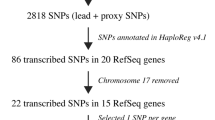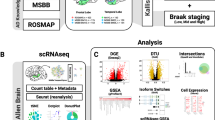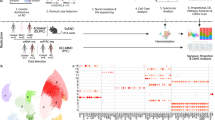Abstract
To more rapidly identify candidate genes located within chromosomal regions of interest defined by genome scan studies in Alzheimer's disease (AD), we have developed a customized microarray containing all the ORFs (n=2741) located within nine of these regions. Levels of gene expression were assessed in total RNA from brain tissue of 12 controls and 12 AD patients. Of all genes showing differential expression, we focused on the ornithine transcarbamylase (OTC) gene on Xp21.1., a key enzyme of the urea cycle which we found to be expressed in AD brains but not in controls, as confirmed by RT–PCR. We also detected mRNA expression of all the other urea cycle enzymes in AD brains. Immunochemistry experiments revealed that the OTC expression was strictly restricted to vascular endothelial cells in brain. Furthermore, OTC activity was 880% increased in the CSF of probable AD cases compared with controls. We analysed the association of the OTC −389 G/A and −241 A/G promoter polymorphisms with the risk of developing AD. We observed that rare haplotypes may be associated with the risk of AD through a possible modulation of the methylation of the OTC promoter. In conclusion, our results suggest the involvement of a new pathway in AD brains involving the urea cycle.
This is a preview of subscription content, access via your institution
Access options
Subscribe to this journal
Receive 12 print issues and online access
$259.00 per year
only $21.58 per issue
Buy this article
- Purchase on Springer Link
- Instant access to full article PDF
Prices may be subject to local taxes which are calculated during checkout




Similar content being viewed by others
References
Cruts M, Van Broeckhoven C . Molecular genetics of Alzheimer's disease. Ann Med 1998; 30: 560–565.
Kamboh MI . Molecular genetics of late-onset Alzheimer's disease. Ann Hum Genet 2004; 68: 381–404.
Roberts SB, MacLean CJ, Neale MC, Eaves LJ, Kendler KS . Replication of linkage studies of complex traits: an examination of variation in location estimates. Am J Hum Genet 1999; 65: 876–884.
Loring JF, Wen X, Lee JM, Seilhamer J, Somogyi R . A gene expression profile of Alzheimer's disease. DNA Cell Biol 2001; 20: 683–695.
Brown VM, Ossadtchi A, Khan AH, Cherry SR, Leahy RM, Smith DJ . High-throughput imaging of brain gene expression. Genome Res 2002; 12: 244–254.
Colangelo V, Schurr J, Ball MJ, Pelaez RP, Bazan NG, Lukiw WJ . Gene expression profiling of 12 633 genes in Alzheimer's hippocampal CA1: transcription and neurotrophic factor down-regulation of apoptotic and pro-inflammatory signaling. J Neurosci Res 2002; 70: 462–473.
Li YJ, Oliveira SA, Xu P, Martin ER, Stenger JE, Scherzer CR et al. Glutathione S-transferase omega-1 modifies age-at-onset of Alzheimer disease and parkinson disease. Hum Mol Genet 2003; 12: 3259–3267.
Blalock EM, Geddes JW, Chen KC, Porter NM, Markesbery WR, Landfield PW . Incipient alzheimer's disease: microarry correlation analyses reveal major transcriptional and tumor suppressor responses. Proc Natl Acad Sci 2004; 101: 2173–2178.
Theuns J, Del-Favero J, Dermaut B, van Duijn CM, Backhovens H, Van den Broeck MV et al. Genetic variability in the regulatory region of presenilin 1 associated with risk for Alzheimer's disease and variable expression. Hum Mol Genet 2000; 12: 325–331.
Lambert JC, Araria-Goumidi L, Myllykangas L, Ellis C, Wang JC, Bullido MJ et al. Contribution of APOE promoter polymorphisms to Alzheimer's disease risk. Neurology 2002; 59: 59–66.
Riazanskaia N, Lukiw WJ, Grigorenko A, Korovaitseva G, Dvoryanchikov G, Moliaka Y et al. Regulatory region variability in the human presenilin-2 (PSEN2) gene: potential contribution to the gene activity and risk for AD. Mol Psychiatry 2002; 7: 891–898.
Lahiri DK, Ge YW, Maloney B, Wavrant-De Vrieze F, Hardy J . Characterization of two APP gene promoter polymorphisms that appear to influence risk of late-onset Alzheimer's disease. Neurobiol Aging 2005; 26: 1329–1341.
Lambert JC, Testa E, Cognat V, Soula J, Hot D, Lemoine Y et al. Relevance and limitations of public databases for microarray design: a critical approach to gene predictions. Pharmacogenomics J 2003; 3: 235–241.
Mirra SS, Heyman A, McKeel D, Sumi SM, Crain BJ, Brownlee LM et al. The consortium to establish a registry for Alzheimer's disease. Part II. Standardization of the neuropathologic assessment of Alzheimer's disease. Neurology 1991; 41: 479–486.
Braak H, Braak E . Neuropathological stageing of Alzheimer-related changes. Acta Neuropathol 1991; 82: 239–259.
Smyth GK, Yang YH, Speed T . Statistical issues in cDNA microarray data analysis. Methods Mol Biol 2003; 224: 111–136.
Ihaka R, Gentleman R . R: A language for data analysis and graphics. J Comp Graph Stat 1996; 5: 299–314.
Yang YH, Dudoit S, Luu P, Lin DM, Peng V, Ngai J et al. Normalization for cDNA microarray data: a robust composite method addressing single and multiple slide systematic variation. Nucleic Acids Res 2002; 30: e15.
Lönnstedt I, Speed TP . Replicated microarray data. Statistica Sinica 2002; 12: 31–46.
Delacourte A, Sergeant N, Champain D, Wattez A, Maurage CA, Lebert F et al. Nonoverlapping but synergetic tau and APP pathologies in sporadic Alzheimer's disease. Neurology 2002; 59: 398–407.
Ohshita M, Takeda H, Kamiyama Y, Ozawa K, Honjo I . A direct method for the estimation of ornithine carbamoyltransferase activity in serum. Clin Chim Acta 1976; 67: 145–152.
Lee JT, Nussbaum RL . An arginine to glutamine mutation in residue 109 of human ornithine transcarbamylase completely abolishes enzymatic activity in cos1 cells. J Clin Invest 1989; 84: 1762–1766.
Akaike H . A Bayesian analysis of the minimum AIC procedure. Ann Inst Stat Math 1978; 30: 9–14.
Bozdogan H . Model-selection and akaike's information criterion (AIC): the general theory and its analytical extensions. Psychometrika 1987; 52: 345–370.
Tregouet DA, Tiret L . Cox proportional Hazards survival regression in haplotype-based association analysis using the stochastic-EM algorithm. Eur J Hum Genet 2004; 12: 971–974.
Wiesinger H . Arginine metabolism and the synthesis of nitric oxide in the nervous system. Prog Neurobiol 2001; 64: 365–391.
Felipo V, Butterworth RF . Neurobiology of ammonia. Prog Neurobiol 2002; 67: 259–279.
Lee TJ, Yu JG . L-Citrulline recycle for synthesis of NO in cerebral perivascular nerves and endothelial cells. Ann NY Acad Sci 2002; 962: 73–80.
Mori M, Gotoh T . Arginine metabolic enzymes, nitric oxide and infection. J Nutr 2004; 134: 2820S–2825S.
Berge KE, Tian H, Graf GA, Yu L, Grishin NV, Schultz J et al. Accumulation of dietary cholesterol in sitosterolemia caused by mutation in adjacent ABC transporters. Science 2000; 290: 1771–1779.
Lawn RM, Wade DP, Garvin MR, Wang X, Schwartz K, Porter JG et al. The tangier disease gene product ABC1 controls the cellular apolipoprotein-mediated lipid removal pathway. J Clin Invest 1999; 104: R25–R31.
Seiler N . Ammonia and Alzheimer's disease. Neurochem Int 2002; 41: 189–207.
Smith CD, Carney JM, Starke-Reed PE, Oliver CN, Stadtman ER, Floyd RA et al. Excess brain protein oxidation and enzyme dysfunction in normal aging and in Alzheimer disease. Proc Natl Acad Sci 1991; 88: 10540–10543.
Branconnier RJ, Dessain EC, McNiff ME, Cole JO . Blood ammonia and Alzheimer's disease. Am J Psychiatry 1986; 143: 1313–1444.
Fisman M, Gordon B, Feleki V, Helmes E, Appell J, Rabheru K . Hyperammonemia in Alzheimer's disease. Am J Psychiatry 1985; 142: 71–73.
Fisman M, Ball M, Blume W . Hyperammonemia and Alzheimer's disease. J Am Geriatr Soc 1989; 37: 1102.
Law A, Gauthier S, Quirion R . Say NO to Alzheimer's disease: the putative links between nitric oxide and dementia of the Alzheimer's type. Brain Res Brain Res Rev 2001; 35: 73–96.
Huang Z, Huang PL, Ma J, Meng W, Ayata C, Fishman MC et al. Enlarged infarcts in endothelial nitric oxide synthase knockout mice are attenuated by nitro-L-arginine. J Cereb Blood Flow Metab 1996; 16: 981–987.
Zlokovic BV . Neurovascular mechanisms of Alzheimer's neurodegeneration. Trends Neurosci 2005; 28: 202–208.
Herrup K, Neve R, Ackerman SL, Copani A . Divide and die: cell cycle events as triggers of nerve cell death. J Neurosci 2004; 24: 9232–9239.
Hamdame M, Buee L . The complex p25/Cdk5 kinase in neurofibrillary degeneration and neuronal death: the missing link to cell cycle. Biotechnol J 2007; 2: 267–277.
Evans TA, Raina AK, Delacourte A, Aprelikova O, Lee HG, Zhu X et al. BRCA1 may modulate neuronal cell cycle re-entry in Alzheimer disease. Int J Med Sci 2007; 4: 140–145.
Acknowledgements
Faiza Bensemain was supported by the France Alzheimer Association. Julie Dumont was supported by INSERM and region Nord-pas de Calais. Frank Hansmannel was supported by the Alzheimer's association (Grant IIRG-06-25487). This work was funded by INSERM (ATC-vieillissement), the Pasteur Institute of Lille and the genopole of Lille. We thank Rose Mary Siminski for her technical help.
Author information
Authors and Affiliations
Corresponding author
Additional information
Supplementary Information accompanies the paper on the Molecular Psychiatry website (http://www.nature.com/mp)
Supplementary information
Rights and permissions
About this article
Cite this article
Bensemain, F., Hot, D., Ferreira, S. et al. Evidence for induction of the ornithine transcarbamylase expression in Alzheimer's disease. Mol Psychiatry 14, 106–116 (2009). https://doi.org/10.1038/sj.mp.4002089
Received:
Revised:
Accepted:
Published:
Issue Date:
DOI: https://doi.org/10.1038/sj.mp.4002089
Keywords
This article is cited by
-
Molecular insights into sex-specific metabolic alterations in Alzheimer’s mouse brain using multi-omics approach
Alzheimer's Research & Therapy (2023)
-
Metabolomics analysis of plasma samples of patients with fibromyalgia and electromagnetic sensitivity using GC–MS technique
Scientific Reports (2022)
-
Altered brain arginine metabolism in a mouse model of tauopathy
Amino Acids (2019)
-
Epigenetics in Alzheimer’s Disease: Perspective of DNA Methylation
Molecular Neurobiology (2018)
-
In human brain ornithine transcarbamylase (OTC) immunoreactivity is strongly expressed in a small number of nitrergic neurons
Metabolic Brain Disease (2017)



